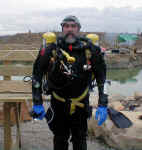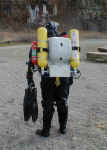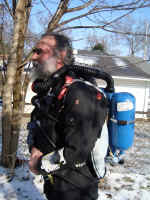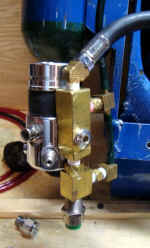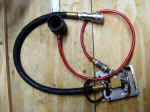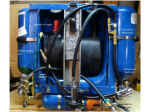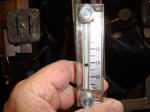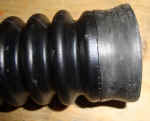The latest modifications have gone a long way in simplifying and streamlining the unit. The left collumn shows the latest configuration and the right is the original system. The latest mod is, as if not more so, user friendly and has more capabilities than the original.
Not shown is we can side mount at least one stage on the left side and then sling normal stages inboard of that. All our stages are equiped with the hydraulic connector used to plumb in diluent.
Due to continuous problems with the leaking standard OPV (Over pressure valve, a type of dry suit exhaust valve), we replaced the standard OPV with OPV's from a lift bag. Over pressurization is dealt with by exhaling from the loop. It was felt that we needed the OPV in the event we forgot to turn of the O2 injection.
We permamently plumbed in the O2 injection system to avoid contaminants blocking the small O2 orifice. We use a 0,076 mm (0.003 in) orifice.
We got rid of the ADV as it was prone to free flowing and leaking. We like the MDV (Manual Diluent Valve) better and it is more reliable.
We eliminated more hoses by teeing the inflator hose with the bailout regulator.
We found we could also top off our supplies through the pressure check ports without disassembley of the unit cylinders. (Just a small mod to the 1st stages)
The PO2 monitor housing was remade for wrist mounting. See PO2 gauge page.
Instead of the anti-collapse rings Draeger uses, which always seemed to move and then the hose would collapse and make a dive most unfriendly, I inserted a 45 degree fitting into the end of the hose. No more problems.
PO2 gauges are now on the forearm.
From the front this unit seemed to be intimidating to divers.
Argon bottle is mounted on the inside bottom under the plate.
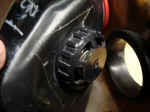
Stiff OPV form a lift bag

O2 sensor placement
O2 injection system
Manual diluent system
Regulator T
Detail overview of components
Flow check
Modification to a loose hose attachment. It is a piece of inner tube strtched over hose end. It has stopped the bad connection that new connectors or hoses would not fix.
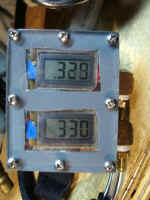
Wrist mounted dual PO2 monitor
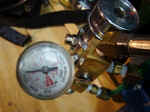
Predive pressure check

